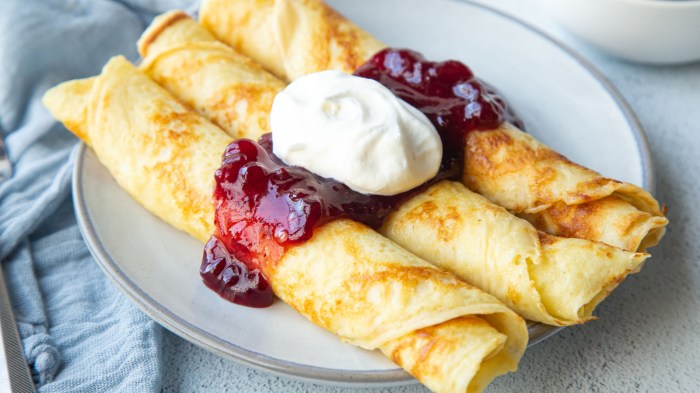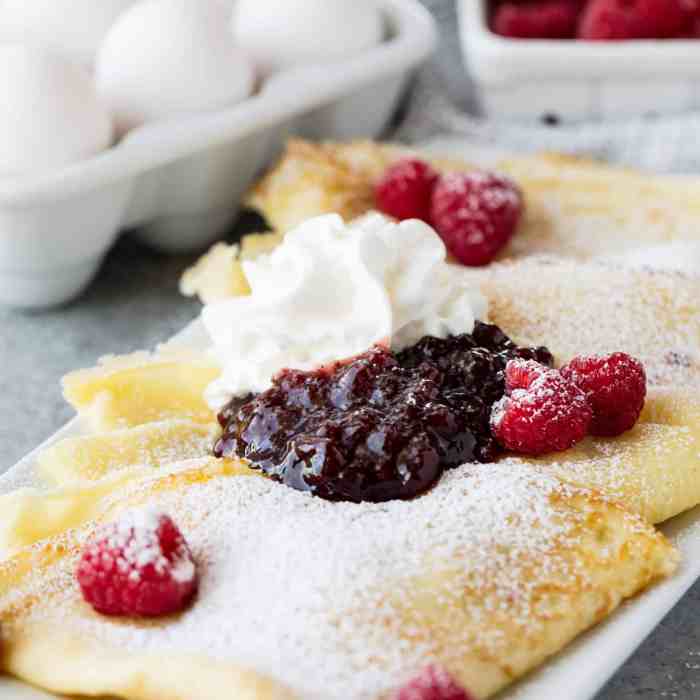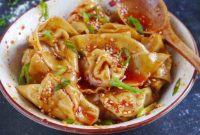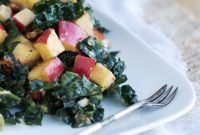In the heart of Swedish culinary heritage, Swedish pancakes, known as “pannkakor,” hold a cherished place. These thin, delicate pancakes, often adorned with sweet or savory toppings, have woven their way into the fabric of Swedish culture, becoming a beloved breakfast staple and a source of national pride.
With a history rooted in centuries of tradition, Swedish pancakes have evolved into a versatile dish, showcasing regional variations that reflect the diverse culinary landscape of Sweden. From the classic simplicity of plain pancakes to the indulgent richness of filled and topped varieties, Swedish pancakes offer a delectable journey through the flavors and traditions of this Nordic nation.
Swedish Pancake History and Origin
Swedish pancakes hold a special place in Swedish culture, enjoyed as a beloved breakfast dish and a staple at special gatherings like Christmas and birthdays. Their origins trace back to the 15th century, influenced by regional variations and culinary traditions.
Cultural Significance
In Sweden, pancakes are deeply ingrained in cultural celebrations. They symbolize prosperity and good fortune, often served during festive occasions like Christmas, Easter, and Midsummer. Pancakes are also a cherished part of family traditions, passed down through generations and shared with loved ones.
Possible Origins and Evolution
The exact origins of Swedish pancakes are debated, with several theories circulating. Some believe they evolved from medieval flatbreads, while others trace their roots to Germanic tribes who settled in Scandinavia. Over time, these early pancakes underwent transformations, influenced by culinary techniques and regional preferences, resulting in the modern-day Swedish pancake we know and love.
Anecdotes and Stories
Throughout history, Swedish pancakes have been intertwined with fascinating stories and anecdotes. In the 17th century, pancakes were considered a symbol of fertility and good luck. Unmarried women would toss pancakes over their shoulders on Midsummer’s Eve, believing the direction the pancake landed would indicate the direction from which their future husband would come.
Distinctive Characteristics of Swedish Pancakes
Swedish pancakes, also known as pannkakor , possess a unique combination of flavors and textures that set them apart from other types of pancakes. Their thin, delicate structure and slightly crispy edges create a delightful contrast to the soft, fluffy interior.
Ingredients and Their Roles
The key ingredients in Swedish pancakes are flour, eggs, milk, butter, and sugar. The flour provides the structure and body of the pancake, while the eggs add richness and help bind the ingredients together. Milk adds moisture and helps create a smooth batter, while butter adds flavor and richness.
Sugar provides sweetness and helps caramelize the edges of the pancakes when cooked.
Comparison to Other Pancakes
Swedish pancakes are thinner and more delicate than American pancakes, and they have a slightly crispy exterior. They are also less sweet than American pancakes, and they are often served with savory toppings such as lingonberry jam, whipped cream, or bacon.
Key Characteristics
- Thin and delicate structure
- Slightly crispy edges
- Soft and fluffy interior
- Less sweet than American pancakes
- Often served with savory toppings
Swedish Pancake Variations and Regional Differences
Swedish pancakes exhibit regional variations across the country, reflecting diverse cultural influences and local preferences. These variations manifest in the taste, texture, and appearance of the pancakes, adding to the culinary richness of Sweden.
Northern Sweden
In the northern regions of Sweden, Swedish pancakes are typically thicker and denser compared to their southern counterparts. They are often made with a batter that includes rye flour, giving them a slightly darker color and a hearty, nutty flavor.
These pancakes are often served with savory fillings, such as lingonberry jam, cured meats, or smoked salmon.
Central Sweden
Central Sweden is known for its classic Swedish pancakes, which are thinner and lighter than those found in the north. The batter is typically made with wheat flour and milk, resulting in a delicate and fluffy texture. These pancakes are often served with sweet toppings, such as whipped cream, fresh berries, or fruit preserves.
Southern Sweden
In southern Sweden, Swedish pancakes take on a more international flair. They are often influenced by neighboring countries, such as Denmark and Germany. These pancakes can be thinner and crispier, similar to French crepes, or thicker and more substantial, resembling German pancakes.
They are often served with a variety of toppings, both sweet and savory.
Gotland
The island of Gotland has its own unique take on Swedish pancakes, known as “plättar.” These pancakes are small and round, with a crispy exterior and a soft, fluffy interior. They are often served with a dollop of lingonberry jam and a sprinkling of powdered sugar.
Skåne
In the southernmost province of Sweden, Skåne, Swedish pancakes are known as “rårakor.” These pancakes are made with a batter that includes grated potatoes, giving them a unique texture and flavor. They are often served with fried pork belly and lingonberry jam.
Traditional Swedish Pancake Toppings and Accompaniments

Swedish pancakes, also known as pannkakor , are traditionally served with a variety of toppings and accompaniments that enhance their flavor and texture. These toppings and accompaniments hold cultural significance and symbolism, representing the rich culinary heritage of Sweden.
Moreover, they provide an opportunity for creativity and personalization, allowing individuals to tailor their Swedish pancake experience to their preferences.
Common Toppings and Accompaniments
- Butter: A classic and versatile topping, butter adds a rich, creamy flavor to Swedish pancakes. It also helps to enhance the pancake’s texture, making it soft and fluffy.
- Lingonberry Jam: Lingonberries are a type of small, red berry that is commonly found in Sweden. Lingonberry jam is a popular topping for Swedish pancakes, adding a tart and tangy flavor that complements the sweetness of the pancakes.
- Whipped Cream: Whipped cream is a light and fluffy topping that adds a touch of sweetness and richness to Swedish pancakes. It is often served alongside other toppings, such as lingonberry jam or fresh fruit.
- Fresh Fruit: Fresh fruit, such as berries, bananas, and apples, adds a pop of color and a burst of sweetness to Swedish pancakes. It also provides a healthy and refreshing contrast to the richness of the pancakes.
- Cinnamon Sugar: A simple but delicious topping, cinnamon sugar adds a warm and inviting flavor to Swedish pancakes. It is often sprinkled on top of the pancakes before they are served.
Cultural Significance and Symbolism
The traditional toppings and accompaniments served with Swedish pancakes hold cultural significance and symbolism. Butter, for example, represents prosperity and abundance in Swedish culture. Lingonberry jam is associated with the Swedish countryside and is often served at special occasions, such as Christmas and Midsummer.
Whipped cream symbolizes celebration and joy, while fresh fruit represents the bounty of nature.
Creative Topping Combinations
In addition to the traditional toppings and accompaniments, there are many creative and unique topping combinations that can be used to enhance the Swedish pancake experience. Here are a few suggestions:
- Nutella and Banana: Spread a layer of Nutella on a Swedish pancake and top with sliced bananas. Drizzle with honey for an extra touch of sweetness.
- Peanut Butter and Jelly: For a classic American twist, spread peanut butter and jelly on a Swedish pancake. Top with whipped cream or a scoop of vanilla ice cream.
- Apple Cinnamon: Sauté apples in butter and cinnamon until they are soft and caramelized. Spoon the apples over Swedish pancakes and top with a dollop of whipped cream.
- Bacon and Maple Syrup: For a savory twist, top Swedish pancakes with crispy bacon and a drizzle of maple syrup. Add a fried egg for a complete breakfast.
- Coconut and Mango: Spread a layer of coconut cream on a Swedish pancake and top with sliced mango. Drizzle with lime juice and garnish with toasted coconut flakes.
These are just a few ideas to get you started. With a little creativity, you can create your own unique and delicious topping combinations to enjoy with Swedish pancakes.
Swedish Pancake Cooking Methods and Techniques
Crafting Swedish pancakes involves a delightful blend of simplicity and artistry, yielding fluffy, golden-brown discs of pure delight. Whether you prefer the classic griddle method or the versatility of a frying pan, the key lies in mastering the art of patience and precision.
Ingredients and Preparation
Begin your culinary journey by gathering the essential ingredients: all-purpose flour, baking powder, sugar, salt, eggs, milk, and butter. Sift together the dry ingredients in a medium bowl to ensure an even distribution. In a separate bowl, whisk the eggs until light and fluffy, then gradually incorporate the milk and melted butter.
Gently fold the wet ingredients into the dry mixture, stirring until just combined. Avoid overmixing to prevent gluten development, which can result in tough pancakes.
Cooking Methods: Griddle vs. Frying Pan
The choice between a griddle and a frying pan hinges upon personal preference and the desired outcome. A griddle provides a large, flat surface, allowing you to cook multiple pancakes simultaneously, ideal for feeding a hungry crowd. On the other hand, a frying pan offers greater control over the cooking process, enabling you to adjust the heat more precisely and flip the pancakes with ease.
If using a griddle, preheat it over medium heat, ensuring an even temperature across the surface. For a frying pan, heat it over medium-low heat, allowing it to warm gradually and evenly.
Pouring and Cooking
Using a measuring cup or ladle, carefully pour a scant ¼ cup of batter onto the preheated griddle or frying pan for each pancake. Allow the batter to spread naturally, forming a circular shape. Resist the urge to spread it with a spatula, as this can result in uneven cooking.
Allow the pancake to cook undisturbed for 2-3 minutes, or until bubbles begin to form on the surface and the edges appear dry. Gently lift the pancake with a spatula, checking the underside for a golden-brown color. Flip the pancake and cook for an additional 1-2 minutes, until the second side is also golden brown.
Tips and Tricks for Perfect Pancakes
- For a light and fluffy texture, allow the batter to rest for 15-20 minutes before cooking. This allows the gluten to relax, resulting in a more tender pancake.
- Use a non-stick griddle or frying pan to prevent the pancakes from sticking. If necessary, lightly grease the surface with cooking spray or butter.
- Cook the pancakes over medium heat to ensure even cooking throughout. High heat can cause the pancakes to burn on the outside while remaining raw on the inside.
- Flip the pancakes only once. Flipping them too often can result in deflated pancakes.
- Serve the pancakes immediately with your favorite toppings, such as butter, syrup, fruit, or whipped cream.
Swedish Pancake Serving Suggestions

Swedish pancakes are a versatile dish that can be enjoyed at any meal. They can be served as a main course, a side dish, or even a dessert. Here are some ideas for incorporating Swedish pancakes into your meals:
For breakfast, Swedish pancakes can be served with a variety of toppings, such as butter and syrup, fruit, whipped cream, or lingonberry jam. They can also be filled with savory ingredients, such as cheese, ham, or vegetables.
Lunch and Dinner Ideas
At lunch or dinner, Swedish pancakes can be served as a main course with a side of soup or salad. They can also be used as a side dish with roasted chicken or fish. For a vegetarian meal, Swedish pancakes can be filled with roasted vegetables or tofu.
Creative Presentation
To make Swedish pancakes more visually appealing, you can fold them into different shapes, such as triangles, squares, or rolls. You can also top them with a variety of colorful ingredients, such as fresh berries, sliced bananas, or chopped nuts.
Sample Menu
Here is a sample menu featuring Swedish pancakes as the main course or as a side dish:
- Appetizer: Swedish pancake bites with smoked salmon and dill
- Main Course: Swedish pancakes filled with roasted chicken and vegetables, served with a side of lingonberry jam
- Dessert: Swedish pancakes with fresh berries and whipped cream
Swedish Pancake Nutritional Value and Dietary Considerations
Swedish pancakes, also known as “pannkakor,” are a cherished breakfast staple in Swedish cuisine. These thin, round pancakes are renowned for their light and fluffy texture, making them a popular choice for special occasions and everyday meals alike. However, it’s essential to understand the nutritional value of Swedish pancakes and consider their impact on overall health and well-being.
The nutritional value of Swedish pancakes varies depending on the specific ingredients used and the cooking method employed. Typically, a single serving of Swedish pancakes (approximately three pancakes) provides the following macronutrients:
- Calories: 200-250
- Carbohydrates: 30-35 grams
- Protein: 5-7 grams
- Fat: 5-7 grams
In terms of micronutrients, Swedish pancakes are a source of:
- Calcium
- Iron
- Potassium
- Vitamin B12
- Riboflavin
Potential Health Benefits
Consuming Swedish pancakes in moderation can offer certain health benefits:
- Energy Source: The carbohydrates in Swedish pancakes provide a quick source of energy, making them an ideal breakfast option to kickstart the day.
- Essential Nutrients: Swedish pancakes contain essential nutrients like calcium, iron, and potassium, which are important for maintaining healthy bones, muscles, and overall well-being.
- Digestibility: Swedish pancakes are generally easy to digest, making them suitable for individuals with sensitive stomachs.
Potential Drawbacks
While Swedish pancakes can be a part of a balanced diet, excessive consumption may pose certain health concerns:
- High Calorie Content: Swedish pancakes are relatively high in calories, so overindulgence can lead to weight gain.
- Refined Carbohydrates: Swedish pancakes are made with refined flour, which lacks fiber and can cause blood sugar spikes if consumed in large quantities.
- Unhealthy Toppings: Traditional Swedish pancake toppings like butter, sugar, and syrup can add extra calories and unhealthy fats, further contributing to weight gain and potential health issues.
Making Swedish Pancakes Healthier
To make Swedish pancakes healthier, consider the following tips:
- Use Whole Grain Flour: Substitute refined flour with whole grain flour to increase fiber content and promote better blood sugar control.
- Reduce Sugar and Butter: Opt for healthier toppings like fresh fruits, yogurt, or nut butter instead of traditional high-calorie options.
- Control Portion Size: Be mindful of portion sizes to avoid overeating and limit calorie intake.
Swedish Pancake Cultural Significance and Symbolism
Swedish pancakes, known as pannkakor , hold a special place in Swedish culture, embodying traditions, festivities, and everyday moments.
Pancake Tuesday ( Fettisdagen ): This annual celebration, typically in February or March, is dedicated to Swedish pancakes. Families and friends gather to indulge in hearty stacks of pancakes, often accompanied by whipped cream, jam, and lingonberry preserves.
Symbol of Prosperity and Abundance
Swedish pancakes are often seen as a symbol of prosperity and abundance. Their round shape and golden color are reminiscent of the sun, a symbol of life and growth. In the past, pancakes were a rare treat, served on special occasions like weddings and holidays, representing wealth and good fortune.
Pancake Races
Pancake races are a fun and lively tradition associated with Swedish pancakes. Participants race while flipping pancakes in pans, adding an element of excitement and laughter to the festivities.
Everyday Comfort Food
Beyond special occasions, Swedish pancakes are a staple in everyday Swedish cuisine. They are a versatile dish, enjoyed for breakfast, lunch, or dinner, and often served with a variety of toppings and accompaniments, reflecting the diverse culinary traditions of Sweden.
Outcome Summary

Swedish pancakes, with their distinctive flavor, texture, and versatility, stand as a testament to the culinary artistry of Sweden. Whether enjoyed as a simple breakfast treat, an elaborate brunch centerpiece, or a delightful dessert, these pancakes embody the essence of Swedish hospitality and warmth.
As you savor each bite, let the flavors transport you to the heart of Sweden, where tradition and innovation blend harmoniously in this beloved culinary creation.
FAQ Summary
What are the key ingredients in Swedish pancakes?
Swedish pancakes typically consist of a simple batter made from flour, eggs, milk, and butter. The exact proportions and additional ingredients may vary depending on regional variations and personal preferences.
How do Swedish pancakes differ from American pancakes?
Swedish pancakes are generally thinner and wider than American pancakes, with a more delicate texture and a slightly tangy flavor. They are also traditionally served with sweet or savory toppings, rather than syrup.
What are some popular regional variations of Swedish pancakes?
Swedish pancakes exhibit regional variations across the country. Some notable variations include:
- Äggakaka: A savory pancake from Skåne, made with eggs, cream, and bacon.
- Plätar: Small, thick pancakes from Västerbotten, often served with lingonberry jam.
- Raggmunk: A potato pancake from Jämtland, typically served with fried pork.
What are some traditional toppings and accompaniments for Swedish pancakes?
Swedish pancakes are commonly served with a variety of toppings and accompaniments, both sweet and savory. Some popular choices include:



